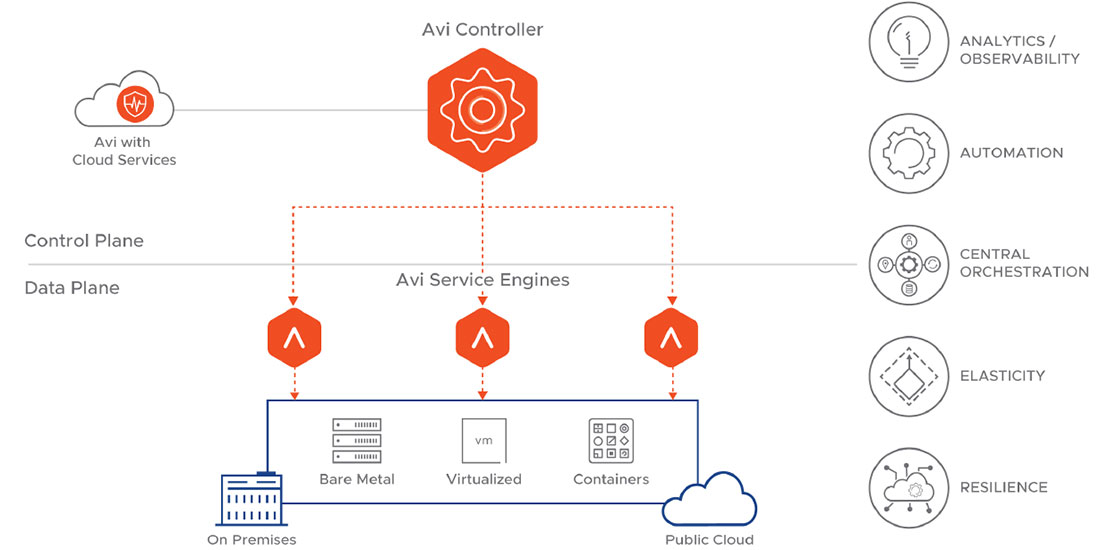VMware NSX
Advanced Load Balancer
(by Avi Networks)
Multi-Cloud Application Services: Load Balancing, Application Security, Container Ingress and Analytics
APPLICATION SERVICES ACCELERATE BUSINESS AGILITY
Enabling remote work while ensuring security with unprecedented speed has dramatically increased the need for applications to be available across different environments, regardless of time zones and peak usage conditions. Legacy infrastructure lacks the elasticity, flexibility, and agility needed to deliver applications securely and reliably. The rise of containers, APIs, and observability needs presents an opportunity for infrastructure to become composable, automated, and intelligent without the limitations of the appliance-based approach. Modern enterprises need an on-demand, fast-to-deploy, easy-to-use app delivery solution that facilitates multi-cloud consistency across on-premises and cloud environments.
SOFTWARE LOAD BALANCER
VMware NSX Advanced Load Balancer (Avi Networks) uses a software-defined architecture that separates the central control plane (Avi Controller) from the distributed data plane (Avi Service Engines). Avi is 100% REST API based, making it fully automatable and seamless with the CI/CD pipeline for application delivery. The Avi Controller is the “brain” of the entire system and acts as a single point of intelligence, management, and control across a distributed fabric of enterprise-grade load balancers, application security, container ingress and analytics. The Avi Controller provides decision automation based on closed-loop telemetries and presents actionable insights based on based on application monitoring, end-to-end timing, searchable traffic logs, security insights, log insights, client insights, and more. See Figure 1.

AGILITY FROM AUTOMATED PROVISIONING AND SELF-SERVICE
Automated virtual service provisioning with per-app load balancing services
- Virtual IP (VIP) provisioning in seconds
- Full automation with REST APIs to support faster application rollout in Blue/Green andCanary deployments and enable DevOps teams with self-service portals
- Simplified operations with centralized policies
- Full lifecycle management through application delivery automation
- No manual per appliance configurations
LOWER COST WITH SIMPLIFIED OPERATIONS
Elastic load balancing and just-right-size capacity without overprovisioning
- No overprovisioned capacity and continuous refresh, upgrades and maintenance ofindividual hardware appliances
- Flexible, subscription- based licensing model that eliminates static capacity
- Reduced OpEx through simplified operations of central management
- No custom active-standby hardware needed with software-defined load balancing on high-performance Intel x86 servers
- Consistent application services across multi-cloud environments without reconfiguration
RAPID RESOLUTION IN SECONDS
Google-search like visibility into network transactions to troubleshoot quickly
- Application health score for a quick snapshot of network posture
- End-to-end round-trip times with latencies between each network hop
- Real-time logging, recording and replaying traffic events
- Granular insights into performance, security, and end user experience
- Point-and-click application troubleshooting – no black box
ELASTIC AUTOSCALING AND HIGH PERFORMANCE
On-demand scale up or down using analytics-driven automation based on real-time traffic
- Self-service provisioning for continuous application delivery
- CI/CD support On-demand load balancing and application autoscaling
- Service Engine failure auto recovery
- Automatically programs network, cloud, and app environments
- Full support for multi cloud - On-Premises mixed with Azure, AWS, Google Cloud Platform